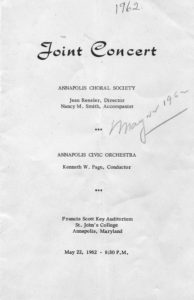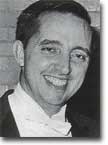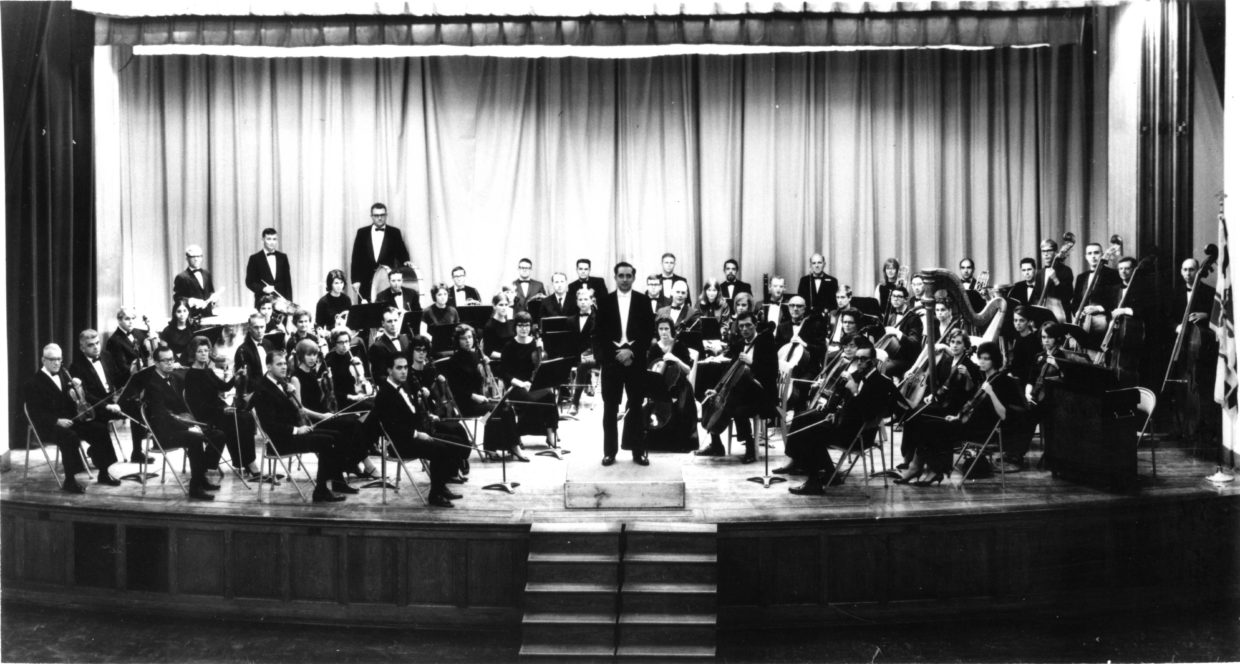Home / About Us / Mission & History
Mission
The mission of the Annapolis Symphony Orchestra is to inspire, educate and enrich lives near and far by creating extraordinary musical experiences with uncompromising artistic excellence.
History
The Annapolis Symphony Orchestra is now entering its 62nd year as the leading performing arts organization in Maryland’s capital city. Featuring 70 professional union musicians who perform for audiences of all ages. An anchor among Annapolis arts and culture organizations for 62 years, the Symphony provides memorable cultural experiences to residents of the region. The Symphony contributes to a vibrant cultural community and generates economic impact for the region.
Where the Music Begins

The Annapolis Civic Orchestra was founded in 1962 by a small group of musicians with a desire to start a local Annapolis ensemble to play classical music. Gilbert McNew, a native Annapolitan and local musician, along with his co-worker Rowe Steel would regularly practice classical repertoire during their lunch hours.
In an effort to recruit more musicians, McNew asked the owner of Academy Music store to contact him if any local musicians expressed an interest in joining an ensemble. Soon after, area newcomer John E. Bornhoeft was in the Academy Music shop inquiring about musicians in Annapolis. He was an experienced violinist who enjoyed performing with other community orchestras and wanted to continue playing with others.
McNew and Bornhoeft connected and the ensemble grew quickly. They added talented young musicians who played a variety of instruments to include strings, woodwinds, and percussion.
The growth of the ensemble presented an unanticipated challenge when the musicians were not all able to see the concertmaster tapping his foot to keep time. They now needed a conductor.
From Civic to Symphony

McNew, a graduate of Annapolis High School, asked his former band leader Kenneth W. Page to take up the role of conductor. Page attended a couple of rehearsals and, in 1961, agreed to be the Annapolis Civic Orchestra’s first Music Director.
With Page’s assistance, the orchestra expanded its membership to 42 members, including talented young students and mature students from a Board of Education adult education course designed to help amateur musicians gain proficiency in orchestral playing.
The first public performance took place on May 22, 1962 with the Annapolis Choral Society under the leadership of Kenneth Page.

In the 1962-1963 season, the Annapolis Civic Orchestra officially became the Annapolis Symphony Orchestra. That same year, John E. Bornhoeft took over the management of secretarial and financial affairs for the orchestra.
Public Support Swells for the Symphony
In the early days of the Annapolis Symphony Orchestra, the talented musicians and Music Director did not take any pay for their rehearsals and performances. Despite this, the Orchestra struggled financially due to rising concert production expenses.
The Evening Capital editorial staff made an impassioned plea on behalf of the orchestra by writing, “At a time when the city is attempting to erect a cultural center, and encourage art in its many forms, the Annapolis Symphony should be generously supported by those of us who are grateful for its services to the community.” Significant support from the Friends of the Annapolis Symphony and community raised funds and logistical support necessary for the symphony to continue.

In response to the appeal, several businessmen and women formed the Annapolis Symphony Orchestra’s first Board of Directors, led by its first president Philip Richebourg.
Just as the Symphony was settling into its role as a mainstay of cultural excellence in Annapolis, the community was shocked by the sudden passing of Kenneth Page in May of 1969.
In The Evening Capital’s page-one story on his passing, he was described as “one of the city’s most well-known public figures…synonymous with music in this county.” It was the end of an era for the Symphony, but the foundation was in place for a stunning future.
The Fleisher Years
Following Page’s passing, the 1969-70 season was scheduled with guest conductors, including legendary concert pianist and Peabody Conservatory Professor Leon Fleisher. Under the leadership of Philip Richebourg, Fleisher agreed to become the Annapolis Symphony Orchestra’s next Music Director.
Fleisher’s years as the Music Director were transformative for the Symphony. He recruited many talented students from Peabody to become members of the orchestra. Fleisher used his status as a world-renowned pianist and conductor to attract his A-list musical friends as guest artists such as Issac Stern, Eugene Istomin, André Watts, Jaimie Laredo, and Charlie Byrd to name a few.
In addition to raising the bar for artistic excellence at the Symphony, Fleisher worked to institute a system of auditions for orchestra members and hired assistant conductors. A young Peabody graduate, Peter Bay, was appointed Assistant Conductor during Fleisher’s tenure.
In 1982, Fleisher conducted his final concert with the Annapolis Symphony Orchestra. He was named Conductor and Music Director Emeritus and an endowment fund was established in his honor.
Steady Growth
The year-long search for a new Music Director brought in more than 100 applications and a series of conductor candidates to the Symphony. In May 1983, Peter Bay was promoted from Assistant Conductor to Music Director.
In 1984, Mr. Bay hired Deborah Freedman as Assistant Conductor. Under Bay’s leadership, the Symphony began new community outreach programs and added a new concert to be performed with the University of Maryland Chorus.
The 1985-86 season marked the Annapolis Symphony Orchestra’s 25th Anniversary and was celebrated with a number of special Silver Jubilee events. The season also provided a time to reflect on the orchestra’s beginnings in 1962. The first two concerts of the season were dedicated to Kenneth Page and John Bornhoeft respectively.
The season finale at The Joseph Meyerhoff Symphony Hall featured the world premiere of Elam Sprenkle’s An Overture (on a text by Oliver Wendall Holmes), which was commissioned by Mrs. Eliot H. Bryant. The orchestra also performed a symphonic work for orchestra and male chorus, featuring the U.S. Naval Academy Glee Club. Leon Fleisher returned for the concert, performing Concerto for Three Hands on Two Pianos with his wife Katherine Jacobson.
A Professional Symphony
In 1987, Anna E. Greenberg was voted in as the new Board President. In this role, she began a series of administrative initiatives to enable the Symphony to serve its patrons more effectively.
Until 1987, the Symphony had to rely on Board Members and volunteers in order to execute administrative and patron service functions.
Persuaded with what most call Greenberg’s gusto, Patricia Edwards accepted the newly created position of Executive Director. Edwards established an office in Maryland Hall for the Creative Arts and mastered the business of running a Symphony. Together, Greenberg, Bay and Edwards expanded the concert season, doubled the Symphony’s budget, increased ticket sales, and instituted a program of salary enhancements for the musicians.
The 1989-1990 season marked Bay’s last season with the Symphony.
Formidable and Incandescent
Following Peter Bay, Gisèle Ben-Dor, the former resident conductor of the Houston Symphony, was named as the new Music Director in 1991. A veteran of the international concert circuit, Ben-Dor brought her unusual and sophisticated programming that fascinated Annapolis audiences. Born and raised in Uruguay to Polish parents, Ben-Dor immigrated to Israel in the early 1970s. She graduated from the Rubin Academy of Music in Tel Aviv and the Yale School of Music.
Pamela Chaconas, Director of Education, and Maestra Ben-Dor launched the Concerts for Schoolchildren program in 1993. Ben-Dor “loved building a children’s concert series which was greatly enhanced by the work of FASO…before each concert.”
In the 1995-1996 season, the Symphony celebrated its 35th anniversary. The season opened with David Ott’s Annapolis Overture, a piece commissioned by Executive Director Patricia Edwards and her husband Arthur. The Symphony also recorded and released its first album.
Edwards announced her retirement from the role of Executive Director in the same season, but not before successfully lobbying for additional staff positions. According to a tribute from Symphony president Mitchell Nathanson, “she has professionalized all of us. Pat defined the position of Executive Director and we evolved into a business.”
In 1996, the Executive Director position was filled by Jane Kenworthy. She was immediately involved in the planning of the Holiday Pops Concert, free pre-concert lectures, and Board and Union negotiations.
The Annapolis Symphony Orchestra became a member of the Musician’s Association of Metropolitan Baltimore in 1996.
The 1996-1997 season marked Ben-Dor’s last season with the Symphony as she accepted the position of Conducting Laureate at the Santa Barbara Symphony in California.
Flash and Fire
The 1997-1998 season was led by a series of guest conductors who were being considered to fill the role of Music Director. After a season of auditions by a variety of conductors, the Symphony Board announced the selection of Dr. Leslie B. Dunner as the fifth Music Director.
Dunner came to the Symphony from the Detroit Symphony Orchestra with a resume that covered a broad range of interests from conducting, composing, educating, to performing as a clarinetist. Under Dunner’s leadership, the Symphony made significant advancements in artistic excellence which allowed the orchestra to grow and expand its reputation as a leading regional orchestra on the rise.
In 2002, the Symphony was awarded one of the first Music Alive Grants offered by the League of American Orchestras to support a composer-in-residence. Stephen Paulus was selected as the Composer-in-Residence for the Symphony’s 40th Season. During his residency, Paulus showcased seven young local composers in a work he premiered with the Symphony titled Dialogues.
In addition to the artistic strides made by the Symphony, Dunner helped to start many important education initiatives that are still serving the community of Annapolis today. This includes the Adopt-a-School program that provides music students at local schools the opportunity to work directly with professional musicians, and Music Van.
Dunner’s final season with the Symphony was in 2002-2003 as he accepted the role of Music Director at The Joffrey Ballet.
Enthusiasm and Excitement
The Symphony Board hosted a search for a new Music Director for the next two seasons, from 2003 to 2005.
José-Luis Novo was announced as the newest Music Director of the Annapolis Symphony Orchestra in 2005. As one of Spain’s most promising conductors, Novo combined his artistic excellence, innovative programming, and collaboration with some of the world’s highest caliber guest artists into extraordinary growth, enthusiastic reviews, and audience excitement.
In 2006, as a part of its enduring commitment to the championing of new music, the Symphony and Maestro Novo conceived the Annapolis Charter 300 Young Composers Competition. The goal of the competition was to celebrate the 300th anniversary of the signing of the Annapolis city charter in 1708 through the commissioning of new orchestral repertoire from composers 35 years and younger.
The winning piece from this two-year competition is titled Tri-Sattawat (Three Centuries) and was written by Thai composer Narong Prangcharoen. The work was recorded during a Masterworks concert in the 2007-2008 season and is featured on the Symphony’s first commercial CD. In recognition of this project, the Symphony was honored with a 2008 ASCAP Adventurous Programming Award in June 2008.
In 2018, Maestro Novo surpassed Leon Fleisher as the longest-serving Music Director in the history of the Annapolis Symphony Orchestra. In the 2018-209 season, the Symphony launched two unprecedented new initiatives. The Annapolis Symphony Academy is a musical training program for pre-college musicians in an environment that values excellence and diversity. And a four-concert Chamber Series was instituted on a subscription basis.
